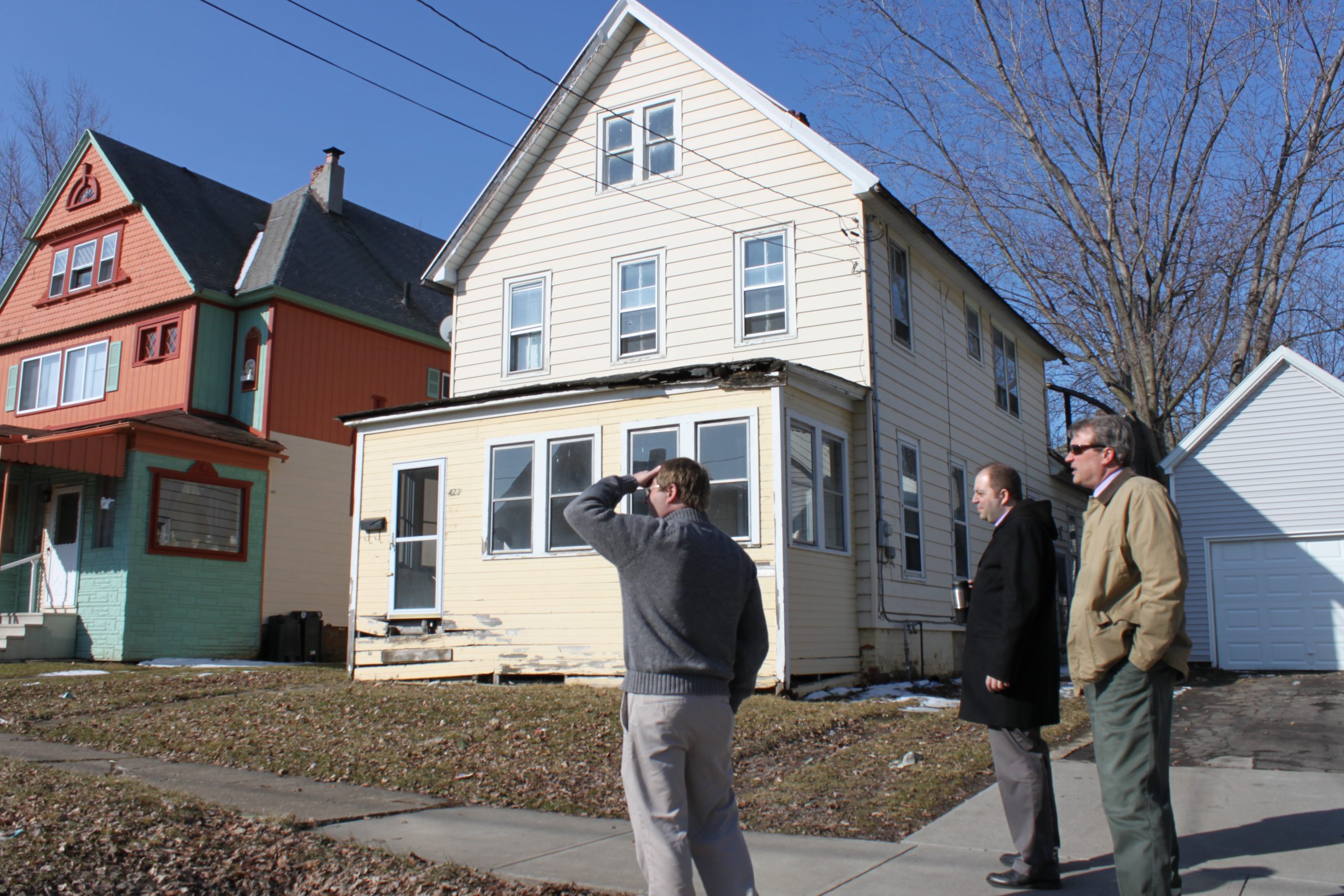Topic(s): Land Banks
Easy as A-B-C: The Chautauqua acquisition model
December 17, 2014


Land Bank ED, Mayor of Dunkirk, City Official visiting land bank homes -Dunkirk, NY (Credit Payton Heins for the Center for Community Progress)
How should a land bank decide which properties to acquire?
Researching our recent national land bank report confirmed it’s a major question that virtually all land banks grapple with. In Take it to the Bank: How Land Banks Are Strengthening America’s Neighborhoods, we found that “though the majority of land banks are practicing more selective acquisition strategies, the majority also shared a desire to increase the acquisition of problem properties in order to address the scale of vacancy that exists and have a larger positive impact in the community.” Land banks are designed to return properties that the market has rejected back to productive use, but doing so can be costly, from fixing disrepair or even demolishing a structure, to providing ongoing maintenance. This can limit how many properties a given land bank may acquire.
In Chautauqua County in rural western New York, the land bank has developed an inventive approach to vacant property acquisition. With a focus on strategically investing its limited budget into neighborhood improvement, the Chautauqua County Land Bank decided on an “A-B-C/1-2-3” acquisition model, acquiring three “A” properties for every two “B” properties and one “C” property.
Fear not, it doesn’t involve a quadratic equation. In this model, “A” properties are those with a stronger market value and sales potential, “B” properties and “C” properties are those that require a greater investment of the land bank’s time and money in order to successfully return them to productive use. So, revenue from the sale of “A” properties assists in the rehabilitation or demolition of “B” “C” properties.
To learn a little bit more about this approach and why the Chautauqua County Land Bank chose it, we talked with Gina Paradis, Administrative Director for the Chautauqua County Land Bank, and Mark Geise, Deputy Director of Planning and Economic Development for Chautauqua County, who has been leading the land bank’s work since it formed. Here are their thoughts:
How did you develop the “A-B-C” acquisition approach? Why did you choose that method of property acquisition?
Mark Geise: A few of the original founders (including myself, Peter Lombardi, Michael Bradshaw and Jim Caflisch) knew that in order for the Land Bank to be successful, we would need to be as self-sustaining as possible, and in order for us to achieve that we would need to have a balance between good properties (A), ok properties (B), and dilapidated properties (C) acquired through the tax foreclosure process. And if we hoped to be sustainable without ongoing public subsidies (beyond the original seed money of $150,000), we would need to make enough on the “A” properties to (1) cover the administration costs, (2) cover the costs of cleaning, securing and making minor enhancements to the “B” properties, and (3) cover the costs to demolish the “C” properties. We based our formula (3 (A)/2 (B) /1(C)) on historical data about the value of the “A” and “B” properties and the aforementioned costs, and estimated the administrative costs to determine the correct proportions of properties so that Chautauqua County Land Bank could be as self-sustaining as possible.
What systems do you have in place to accurately categorize a property as “A,” “B,” or “C”?
Gina Paradis: There isn’t a specific “system” in place, although we have policies and procedures that were adopted by the land bank board that describe in general terms the characteristics of “A”, “B” and “C” properties and the process for choosing said properties. Our Property Acquisition and Disposition Committee annually reviews all of the properties available through the tax foreclosure process, categorizes them, and then recommends to the board what properties it should acquire. Due to the New York Office of the Attorney General grant funding we are receiving, we have been acquiring far more “C” properties (demolition properties) than we would have had we not received this funding, so our formula is currently skewed.
What do you see as the biggest advantage or success of the A-B-C approach?
Mark Geise: Although time will tell, it is a self-sustaining model that does not rely on ongoing public subsidies once the proportions of “A”, “B” and “C” properties are fine-tuned and economies of scale kick in. In other words, if we have enough good “A” properties, the revenue from their sale should cover the acquisition and disposition of the “B” and “C” properties. Just to be clear, the “A” properties need to fit our mission as well; in other words, we can’t acquire the “A” properties just for the sake of flipping them and making money if they don’t fit our mission. The Chautauqua County Land Bank is not a repository for ALL of the dilapidated/unwanted properties. We take the good with the bad in the correct proportions so that we can turn all of our properties over, and have enough revenue to be as self-sustaining as possible.
Download a PDF of Take it to the Bank: How Land Banks Are Strengthening America’s Neighborhoods, or preorder a hard copy to learn more about the work of the Chautauqua County Land Bank, and other land banks who have adopted different acquisition and disposition approaches, uniquely tailored to their respective local contexts.
(Note: The “A-B-C” formula is still evolving, and as the Chautauqua Land Bank has matured in its work, it’s found the “A-B-C” formula should probably be closer to a 4/2/1 proportion)
Subscribe to join 14,000 community development leaders getting the latest resources from top experts on vacant property revitalization.
